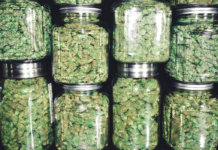Names have power. The more powerful the name, the more likely it will outlast its actual meaning and take on an entirely new definition of its own. The tale of two strains, Sativa and indica, are two standard terms that are frequently used (and misused) by medical cannabis and recreational users alike to categorize and describe specific strains. All produced cannabis strains inevitably owe their ancestry to their “Adam and Eve” parent strains, Sativa and Indica. Just as there are different types of apple trees which all yield apples, sativa and indica are just diverse evolutionary manifestations of the same cannabis species. More on the tale of these two strains below.
 The Difference Between The Tale of Two Strains
The Difference Between The Tale of Two Strains
It’s important to note that over time, the terms sativa and indica have been appropriated from their original scientific classifications and repurposed to serve very different meanings.
Cannabis growers know cannabis sativa (C. Sativa) as tall, lanky plants with narrow leaflets. Cannabis indica (C. indica) are stocky, short plants that feature broad signature leaves. Cannabis ruderalis is a deficient THC-producing species.
Evolution is the reason for the different physical attributes between the two strains. Tall, lanky sativas thrive in wet locations near the equator like Mexico and southeast Asia because their height acts as an evolutionary defense measure to protect it against mold infection.
Conversely, indicas grow in much more bitter conditions like the kush mountain regions of Pakistan and parts of Afghanistan, where the environment can be frigid and windy. As a direct result, indica plants evolved to be short, stubby and generate high amounts of THC resin to protect itself from its harsh climate.

Sativa and Indica: Public Misconceptions and Science
When the general public uses the words, sativa, and indica, they’re usually accompanied by the following common oversimplifications. Sativa cannabis strains generate more of an energizing effect that is optimal for social and daytime. Conversely, indica cannabis strains are soothing and are for winding down at night. These widely-held cannabis conventions are categorically false.
Well-respected medical cannabis researcher, Ethan Russo flatly denies these widely held but ultimately false notions about strain type and their desired effect, stating:
“The way that the sativa and indica labels are utilized in commerce is nonsense. The clinical effects of the cannabis chemovar have nothing to do with whether the plant is tall and sparse vs. short and bushy, or whether the leaflets are narrow or broad.”
Factors Medical Patients Need to Consider When Choosing Their Cannabis
With public assumptions about sativa and indica debunked, it begs the question: which factors should medical cannabis patients consider when looking for strains that work for them? Patients should carefully examine THC, CBD concentrations and if possible, terpene profiles.
The following three examples of cannabis strains patients should consider are:
1.) CBD dominant strains

These strains contain significantly more CBD amounts than THC. Medical users wishing to avoid the psychoactive effects of THC should opt for CBD dominant strains, or even pure CBD products such as cannabis oils, extracts, and oral sprays.
2.) THC dominant strains

These strains have been bred and cultivated to contain mostly THC to CBD. THC dominant strains generally appeal more to recreational users rather than medical patients. However, scientific studies have indicated that cannabis products containing 9 percent THC have yielded beneficial results in pain management as well as sleep onset.
3.) Hybrid strains

These are known as mixed strains that are made up of both sativa and indica. What’s fascinating to note here is that hybrid strains can vary across the board. “Good Vibe” is a THC-heavy strain, “1:1” features equal amounts of THC and CBD and “CBD 20:1” has been cultivated to contain twenty times as much CBD than THC. These “1:1” strains are also known as balanced strains.
 Health Benefits of Sativa and Indica
Health Benefits of Sativa and Indica
Now with misconceptions about sativa and indica stripped away, it’s time to focus on the medical health benefits, specifically derived from CBD. For decades, medical patients have been using CBD to help alleviate symptoms directly related to chronic pain. Dr. Russo explains this in great detail:
“CBD is a versatile anti-inflammatory analgesic through numerous distinct mechanisms, and various other minor cannabinoids and terpenoids in Cannabis certainly may contribute notably to the therapeutic profile of Cannabis. Numerous basic science and even clinical trial data support the concept of herbal synergy in Cannabis beyond the effects of single components. We are only seeing the very beginnings of the therapeutic potential of this plant!”
This statement is not to say that THC has no redeeming health qualities; it does, especially in boosting the quality of life, appetite stimulation, and pain management. Dr. Russo uses the analogy of a symphony to illustrate the synergistic inner workings behind the “Entourage Effect.” Cannabinoids work in unison with each other to create more substantial, cumulative effects.
“This [Entourage Effect] concept was first espoused by Drs. Mechoulam and Ben-Shabat more than 15 years ago to explain how certain components of the endocannabinoid system boost the therapeutic effects of its main players, anandamide and 2-arachidonylglycerol.4,5 Thus, it is akin to a symphony, in which many musicians support and harmonize the melody provided by the soloists. The same analogy fits well the synergistic phenomena observed in Cannabis, whose various components boost and compliment those of its better-known ones, THC and CBD.”
 The Final Word
The Final Word
It’s very tempting to want to organize things in a binary fashion. With the knowledge available, it’s time to discontinue the myth that sativa cannabis strains are invigorating while indica cannabis strains are calming sedatives and sedative-like. Instead, it’s best to use CBD and THC as the variables of choice that lead to a decision to a suitable cannabis product that works best for you.
However, if medical patients can always use Cannalogue’s smart search features to locate products by sativa or indica.
In keeping with our focus on patient care, all cannabis products listed on Cannalogue.ca can be searched and categorized by Sativa/Indica strain type as well as including useful THC and CBD concentrations.





